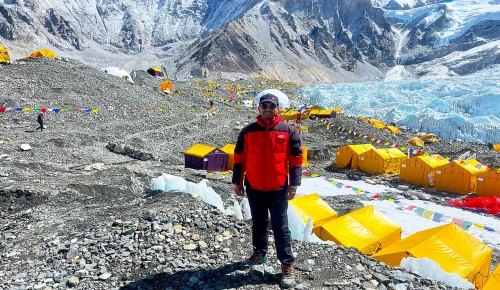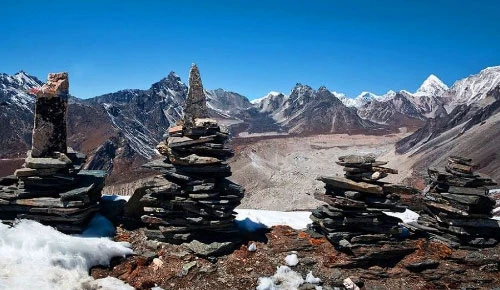Chitwan National Park
Chitwan National Park is known as the “Heart of the Jungle” and the “Leopard Jungle.” This is one of Asia's most well-known and biologically varied conservation zones. This park was founded in 1973, and in 1984 it was listed as a UNESCO World Heritage Site. It occupies a total area of 952.63 square kilometers.
The park is a major asset to Nepal's tourist sector and is located in the Terai area, which includes portions of the districts of Makwanpur, Nawalparasi, Parsa, and Chitwan.
The wide diversity of plants and animals found in Chitwan National Park is one of its main draws. Several unique species of animals can be seen in the park, such as the well-known Bengal tiger, Asian elephant, sloth bear, one-horned rhinoceros, and gharial crocodile.

It is also home to more than 550 different species of birds, which makes it a birdwatcher's paradise. Numerous species find homes in the park's varied ecosystems, which span from grasslands and deep tropical jungles to riverine woods.
Activities available to tourists in Chitwan National Park include elephant rides, birding expeditions, canoe journeys along the Rapti and Narayani rivers, and jungle safaris.
Experiences with Tharu culture, such as village excursions and traditional dance shows, also shed light on the indigenous way of life in the area.
Travelers wishing to see the park's natural treasures can stay in cozy accommodations thanks to its network of hotels and resorts.
Essential Information of Chitwan National Park
Feature | Details | ||||||
Location | Southern Nepal, subtropical lowlands of the inner Terai | ||||||
Area | 952.63 sq. km | ||||||
Buffer Zone | 729.37 sq. km | ||||||
Established | 1973 (as Nepal's first national park) | ||||||
UNESCO World Heritage | Recognized in 1984 | ||||||
Entry Fees (Foreigners) | Approximately NPR 1,180 per person/day (plus VAT)* | ||||||
Total Number of Species | 700+ plant species, 50+ mammals, 525+ birds, 55+ reptiles & amphibians, 120+ fish | ||||||
Best Season to Travel | October-March (cooler, drier weather) | ||||||
Key Attractions | One-horned rhinoceros, Royal Bengal tiger, elephants, gaur, sloth bears, leopards, deer, birdlife, Tharu culture | ||||||
Popular Activities | Jungle safaris (elephant, jeep), canoe rides, birdwatching, nature walks, cultural visits | ||||||
Table of Contents
![Kathmandu to Chitwan Flight Ticket]() Kathmandu Chitwan
Kathmandu ChitwanKathmandu to Chitwan Flight Ticket
History of Chitwan National Park
Chitwan National Park is a UNESCO World Heritage Site and one of Nepal's most famous protected regions, located in the subtropical inner Terai lowlands of south-central Nepal.
Its rich and diverse past is a testament to the preservation of its biodiversity as well as the value of its natural surroundings.
Chitwan National Park was once known as the Royal Chitwan National Park when it was first created in 1973 as a royal hunting reserve. Its establishment marked a turning point in Nepal's conservation history by emphasizing the value of protecting species and their habitats.
The main goal of the park was to protect the remaining populations of rare and endangered animals, including the Bengal tiger and the larger one-horned rhinoceros, which were both seriously threatened by habitat loss and hunting.
Chitwan National Park's recognition as a UNESCO World Heritage Site in 1984 highlighted its importance for biodiversity protection on a worldwide scale. This acknowledgment increased support for the park's management and maintenance while also bringing attention to the biological significance of the area on a global scale.

The park has seen a number of difficulties over time, including poaching, encroachment, and disputes between people and animals. These difficulties were solved with coordinated conservation activities, community-based initiatives, and habitat restoration projects.
At present, Chitwan National Park is a well-liked location for ecotourism and outdoor activities, in addition to being a sanctuary for animals.
Its varied landscapes, which range from lush grasslands and deep woods to twisting rivers and marshes, provide visitors with the chance to explore and take in a diversity of animals, including deer, crocodiles, elephants, and over 500 kinds of birds.
Flora and Fauna of Chitwan National Park
Chitwan National Park is home to diverse flora and fauna. Here is detailed information regarding the flora and fauna of Chitwan National Park.
Flora
There are more than 700 different kinds of flora in the park. Around 70% of the land is covered with sal forest, which is the predominant form of flora.

An additional 20% is made up of grasslands, which contain a variety of grass species, including the enormous elephant grass.
- The majority of the forest in this national park is covered by Sal trees. Sal trees are able to grow to remarkable heights and are an essential part of many animal species' habitats.
- The park is distinguished not just by sal trees but also by mixed deciduous woodlands. Numerous tree species may be found in these woods, including axlewood (Anogeissus latifolia), silk cotton (Bombax ceiba), rosewood (Dalbergia sissoo), and others.
- Riverine woods are abundant along the banks of the Rapti and Narayani rivers. A wide variety of plant species, including different kinds of grasses, shrubs, and trees like khair (Acacia catechu) and sissoo (Dalbergia sissoo), can be found in these woods, which are suited to frequent flooding.
- Large grasslands can be found in Chitwan National Park, and these areas are essential for the survival of many herbivorous animals, including deer and rhinoceroses. Tall elephant grass (Saccharum spp.) predominates these grasslands, with shorter grass species scattered throughout.
- In addition, the park has a variety of wetlands, such as lakes, ponds, and marshes. A wide variety of aquatic plants, including water lilies, lotuses, and many kinds of submerged and floating plants, can be found in these wetlands.
- Chitwan National Park is home to a wide range of epiphytic plants, including mosses, ferns, and orchids, which grow on the trunks and branches of trees and contribute to the park's total biodiversity in addition to the major tree species.
Fauna
The park is also home to more than fifty species, such as the well-known one-horned rhinoceros, the magnificent Royal Bengal tiger, wild elephants, sloth bears, leopards, and other deer species.

The park is home to over 525 different kinds of birds, making it a birdwatcher's dream. There are more than 55 species of amphibians and reptiles, including lizards, tortoises, pythons, cobras, and crocodiles.
The Narayani-Rapti River system, which passes through the park, is home to around 120 species.
- Rhinoceros unicornis, the one-horned rhinoceros, is the national park of Chitwan's symbol.
- The flagship species and top predator is the Bengal tiger (Panthera tigris tigris).
- In the park's meadows and woodlands, visitors can frequently encounter Asian elephants or Elephas maximus.
- Melursus ursinus, the sloth bear, is mostly found in the park's steep regions.
- The park's waterways are home to the highly endangered gharial crocodile (Gavialis gangeticus).
- Another crocodile species found in the park is the mugger crocodile (Crocodylus palustris).
- Commonly observed in herds are sambar deer (Rusa unicolor) and spotted deer (Axis axis).
- The park's animal fauna also includes barking deer (Muntiacus muntjak) and wild boar (Sus scrofa).
- More than 525 different bird species are found in the birds, including the great hornbill, Bengal florican, and several stork, eagle, and vulture species.
- The park is home to a variety of turtle and lizard species, as well as reptiles including cobras and pythons.
Endangered Species
The one-horned rhinoceros and the famous Bengal tiger (Panthera tigris tigris) are two of the park's most seriously threatened species.
Although poaching, habitat loss, and human-wildlife conflict pose risks to the tiger population, conservation initiatives within the park are intended to lessen these effects.
Similar to this, effective recovery efforts have helped save the one-horned rhinoceros from extinction, although the animal is still at risk from horn poaching.
The biggest species of wild cow, the Gaur, and the crocodile, the Gharial, are also classified as endangered in the park.
To ensure the survival of these species for future generations, measures to protect and conserve them include anti-poaching patrols, habitat restoration, community engagement, and awareness campaigns.
Activities to do in Chitwan National Park
- Jungle safaris: Travelers can take an elephant or guided jeep safari to discover the park's varied fauna.
- Birdwatching: With the assistance of our knowledgeable guides, travelers can spot more than 550 bird species, including uncommon and migratory birds.
- Elephant rides: Visitors can also travel through the jungle aboard kind elephants to get a unique perspective of the park.
- Canoe trips: Travelers can take a traditional dugout canoe ride along the Rapti or Narayani River while keeping an eye out for animals along the riverbanks.
- Nature walks: Visitors will get the opportunity to discover the park's flora, wildlife, and hidden gems by taking leisurely strolls with informed guides.
- Cultural Experience: Experience the dynamic culture of the indigenous Tharu people by going to dance performances, doing village visits, and staying in a homestay.
- Wildlife photography: With the help of seasoned photographers, travelers can take breathtaking pictures of the park's varied species and scenery.
- Go to the Center for Gharial Breeding: They can also go to discover the initiatives being taken to conserve the critically endangered gharial crocodile and see the hatchlings in a safe haven.
Buffer Zone of Chitwan National Park
Chitwan National Park's buffer zone is an important region that encircles the park's main area. It is nearly as large as the national park itself, covering an area of around 729.37 square kilometers (952.63 sq. km).
Villages near Chitwan National Park
There are several villages close to this park that provide an insight into the customs and lifestyle of the area. Below are a handful of the more noteworthy ones:
Sauraha: Sauraha is considered the "Gateway to Chitwan." It is a well-liked tourist destination with a range of lodging choices, eateries, and retail establishments. The Tharu Village, a living museum exhibiting the customs of the native Tharu people, is also located in Sauraha.
Meghauli: Meghauli is a little community south of Sauraha that is well-known for its calm environment and closeness to the Rapti River. Travelers looking for a quiet getaway in the middle of nature can find a more laid-back experience here.
Chitwan Tharu Village: This village offers a genuine cultural experience and is located close to Sauraha. Through participation in cultural performances and demonstrations, visitors can gain knowledge about the distinctive customs, traditions, and way of life of the Tharu people.
Kasara: Kasara, situated by the Rapti River, is well-known for both its elephant breeding facility and its involvement in elephant conservation initiatives. In addition to interacting with the mahouts (elephant riders) who look after the animals, visitors get to see elephants in their natural environment.
While staying in one of these villages, guests can view the beauties of this park and get a unique glimpse into the region's cultural tapestry.
Entry Fees for Chitwan National Park
Depending on visitor nationality, Chitwan National Park has different entrance fees:
- Citizens of Nepal: NRs. 150 each person, each entrance
- SAARC, nation citizens NRs. 1,000 per person to enter.
- For foreigners, it costs NRs. 2,000 per person.

Additional Details:
- Youngsters under ten can enter the park free of charge
- The cost of the park will be valid only for a day
- Tickets are available for purchase at the park's entrances or the Tourist Service Center in Kathmandu.
- For easier transactions, it is advised to carry the correct amount in Nepalese rupees.
Important Policies while visiting Chitwan National Park
It's crucial to follow specific rules and regulations when visiting this park to protect the park's natural resources and tourists' safety. These are some standard guidelines and procedures that are usually adhered to:
- Respect the wildlife by keeping a safe distance from them and not upsetting them in their natural surroundings. Never feed or agitate wildlife.
- Stay on authorized trails to reduce your influence on the environment and prevent getting lost.
- Make sure to dispose of trash appropriately to keep the park clean. Take care of any trash you produce while you're there.
- To lower the risk of wildfires, smoking and open flames are generally forbidden in protected areas.
- Show consideration for the communities that live close to the park's boundaries. Observe cultural customs and ask for permission when required.
- It is forbidden to hunt, trap, or gather any kind of plant, animal, or souvenir within the park.
- To prevent confrontations with wildlife and preserve the environment of the park, pets are not permitted within national parks.
- Before accessing the park, get any required permits or passes. Be mindful of the rules and admission costs.
- Follow the rules while taking pictures of wildlife and refrain from using flash, especially when taking pictures of vulnerable animals.
- Try not to make too much noise so as not to interfere with the experiences of other guests and wildlife.
Exploring the Treasures of Chitwan National Park
To sum up, Chitwan National Park is evidence of Nepal's dedication to biodiversity preservation and protection.
Tucked away in the verdant Terai area, this sanctuary is home to a staggering variety of flora and animals, including threatened species like the Bengal tiger and one-horned rhinoceros.
Travelers are exposed to breathtaking interactions with nature in its most pristine state as they stroll through its lush landscapes and winding waterways.
This park is a real example of the close relationship that exists between people and the environment, and it is not only a refuge.
Locations like Chitwan serve as rays of hope as we confront the problems of environmental degradation and the extinction of species, emphasizing the critical need to save our planet's priceless natural inheritance for future generations.








